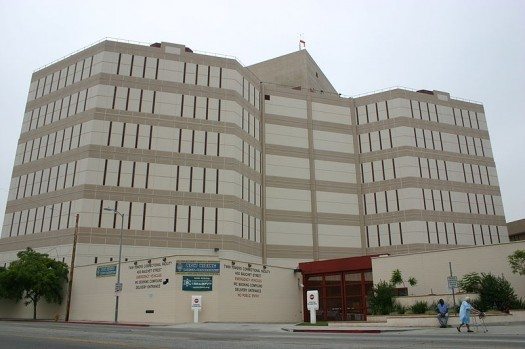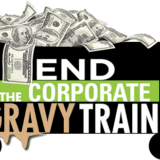

 Cherri Senders wasn’t always looking for the union label. Back in the late 1980s the Washington, D.C. native was writing for the L.A. Weekly, an alternative newspaper that was generous with editorial pleas for social justice but miserly when paying its own workers.
Cherri Senders wasn’t always looking for the union label. Back in the late 1980s the Washington, D.C. native was writing for the L.A. Weekly, an alternative newspaper that was generous with editorial pleas for social justice but miserly when paying its own workers.
“I saw how exploited writers were,” Senders tells Frying Pan News. “We joined the National Writers Union and were able to go from five cents a word to seven. That’s how I found out about the labor movement.”
About 15 years later a friend of Senders, who by then had started her own communications company, wanted to learn how to purchase union-made baby products, but couldn’t find a way to track down which ones bore a union label.
There had always been Buy Union lists – often out of date and pinned to the bulletin boards of union halls or,
» Read more about: Looking for the Union Label in All the Right Places »


Guilt — in the psychoanalytic tradition — is both a form of self-punishment and a key obstacle to therapeutic improvement. In The Ego and the Id, Freud wrote that the patient finds “satisfaction in the illness and refuses to give up the punishment of suffering.” In a paradoxical way, obsessive guilt becomes a masochistic attempt at an unreliable cure.
The Company You Keep, starring and directed by Robert Redford, is a film awash in guilt. Redford’s character, Jim Grant, an ex-radical still “hiding” in plain sight, feels guilt about his past and about the secrets he has to withhold from his daughter. A reporter, played by Shia LaBeouf, eventually feels guilty about the impact his bulldog reporting might have on the people he’s writing about. A tenured radical professor feels guilty about not keeping up “the struggle,” unable to inspire his students beyond a round of applause at the end of his stories.
» Read more about: The Sixties: What a Long, Strange Guilt Trip It’s Been »


(As the May 21 mayoral runoff election approaches, Frying Pan News is asking voters what they believe the next mayor’s priorities should be — as well as what he or she should avoid doing once in office. This week reporter Marc Haefele interviews three San Fernando Valley voters near the corner of Van Nuys and Burbank boulevards; all three women are Van Nuys residents.)
Karen Rontowski
We do need a better distribution of wealth in our city. At the same time, we need more funding for both teachers and police. Of course I’d like to see more jobs, but how much can the mayor alone do to accomplish something like that? Maybe we can only work with that problem on the national level. There was a lot of flash to Antonio Villaraigosa and yet not too much substance.
» Read more about: L.A. Mayor’s Race: The View from the Valley »


 For five years a chorus of voices has been predicting bankruptcy for Los Angeles, while often calling for deeper cuts to city employee pensions. Today, however, Mayor Antonio Villaraigosa proposed a budget for Fiscal Year 2013-2014 that includes a one-time surplus of $119 million. While some of that surplus would rely on additional pay and benefit reductions for city workers, even without such cuts the city would have a projected surplus of close to $100 million.
For five years a chorus of voices has been predicting bankruptcy for Los Angeles, while often calling for deeper cuts to city employee pensions. Today, however, Mayor Antonio Villaraigosa proposed a budget for Fiscal Year 2013-2014 that includes a one-time surplus of $119 million. While some of that surplus would rely on additional pay and benefit reductions for city workers, even without such cuts the city would have a projected surplus of close to $100 million.
“It’s better than seeing the light at the end of the tunnel – we’re almost out of the tunnel!” Matt Szabo, Mayor Villaraigosa’s deputy chief of staff, told Frying Pan News in an interview last week. Szabo discussed the city’s financial picture and said that dire financial warnings have been largely overblown.
“One of the issues that’s highly irritating is the ease with which some people have thrown around the bankruptcy term,” Szabo said.
» Read more about: Budget Shocker: L.A. Shows $119 Million Surplus »


 After several years of swimming in red ink, the city of Los Angeles is now projecting a $119 million surplus for Fiscal Year 2013-2014, according to city documents presented at a news conference today presided over by Mayor Antonio Villaraigosa. (See Page 3 of the mayor’s Budget Presentation.)
After several years of swimming in red ink, the city of Los Angeles is now projecting a $119 million surplus for Fiscal Year 2013-2014, according to city documents presented at a news conference today presided over by Mayor Antonio Villaraigosa. (See Page 3 of the mayor’s Budget Presentation.)
City Administrative Officer Miguel Santana and other officials also attended the media event at City Hall.
The surplus is dependent on the city receiving certain one-time revenues, much of them due from the state and federal governments.
Nevertheless, this disclosure dramatically rebuffs a steady stream of predictions, made by an array of officials, mayoral candidates and commentators, that L.A. faces the possibility of bankruptcy. Such predictions have invariably been accompanied by calls to reduce the pension benefits of city employees.
Later this morning Frying Pan News will post investigative reporter Gary Cohn’s analysis of what has produced the surplus – and of the motivations behind predictions of the city’s insolvency.
» Read more about: Bulletin: New L.A. Budget Shows $119 Million Surplus »


With jails straining to absorb thousands of prison inmates, jailhouse guard-on-inmate beatings grabbing headlines, and public concern rising about possible spikes in crime rates, public safety issues—especially around the massive Los Angeles County jail and probation systems—have Angelenos of all stripes scrambling for answers.
The just-concluded three-part, “Smart Justice: Rethinking Public Safety in California” discussion at the University of Southern California, capped off with a fourth session at the Pat Brown Institute, brought together key leaders—from top L.A. County public safety managers to heads of organizations charged with monitoring those systems—to identify often well-known problems, but also to propose potential solutions, cures that generally involve replacing “punishment” with “rehabilitation” in corrections thinking.
A Combustible Environment
“Los Angeles County has the largest probation department in the nation, the largest sheriff’s department, and the third largest police force in the L.A. Police Department,” said Alex Johnson from the Office of County Supervisor Mark Ridley-Thomas.
» Read more about: Facing Los Angeles’ Incarceration Dilemma »


Weeks after a political stalemate set in motion $85 billion in federal spending cuts for fiscal year 2013, sequestration has shifted from a political debate in the halls of Congress to a looming reality in neighborhood streets – especially in some of the poorest areas of the country.
In Georgia, the drop in federal dollars is taking an 11 percent bite out of extended unemployment benefits that more than 61,000 Georgians depend on for food, utilities and housing, according to the Rome News-Tribune.
In Mississippi, 2,300 children under the age of three will likely lose the care and early education they receive in federally-supported Early Head Start programs.
And in Texas’s Rio Grande Valley, sequester will mean cuts in legal aid services and housing vouchers for low-income families and reductions in job-search services for the unemployed.
Many community organizations that serve low-income families are already feeling the money pinch.
» Read more about: Sequester Taking a Toll on America’s Needy »


 The reason President Obama’s proposal to cut Social Security benefits is tragic is that it is simply not necessary. His plan is to use a different method to compute how much benefits are raised to offset inflation. But Social Security will add very little to federal spending over the next 30 to 40 years. As a proportion of national income (GDP), It will rise from five percent to six percent. At the same time, retirees are set to get much less money from their pensions because so many were forced to depend on 401(k)s and defined contribution plans rather than traditional pensions with defined benefits.
The reason President Obama’s proposal to cut Social Security benefits is tragic is that it is simply not necessary. His plan is to use a different method to compute how much benefits are raised to offset inflation. But Social Security will add very little to federal spending over the next 30 to 40 years. As a proportion of national income (GDP), It will rise from five percent to six percent. At the same time, retirees are set to get much less money from their pensions because so many were forced to depend on 401(k)s and defined contribution plans rather than traditional pensions with defined benefits.
But a new report from Goldman Sachs economists puts the Obama decision in an even harsher light. The federal deficit is coming down rapidly on its own. In a piece entitled, “The Rapidly Shrinking Federal Deficit,” Goldman notes that the deficit averaged 4.5 percent of GDP in the first calendar quarter,
» Read more about: The U.S. Deficit Is Down — So Why Cut Social Security? »


 Hundreds of workers descended on the Capitol yesterday as part of the California Labor Federation’s legislative conference lobby day with a simple message for both Democrats and Republicans in office: “End the Corporate Gravy Train.” They were referring to the state’s wasteful enterprise zone program, which takes money away from schools, infrastructure and other valuable services to line the pockets of corporate CEOs at Walmart and other large, profitable corporations.
Hundreds of workers descended on the Capitol yesterday as part of the California Labor Federation’s legislative conference lobby day with a simple message for both Democrats and Republicans in office: “End the Corporate Gravy Train.” They were referring to the state’s wasteful enterprise zone program, which takes money away from schools, infrastructure and other valuable services to line the pockets of corporate CEOs at Walmart and other large, profitable corporations.
At a lunchtime rally, workers, labor leaders and elected officials railed against this massive giveaway and urged support for SB 434, a reform bill authored by State Sen. Jerry Hill. The event coincided with the launch of a new website, www.EndTheCorporateGravyTrain.com, which details the wasteful program and exposes some of the massive companies that are riding the gravy train.
California Labor Federation Executive Secretary-Treasurer Art Pulaski:
“Taxpayers are sending $700 million per year straight into the pockets of corporate executives without seeing good jobs created in return.
» Read more about: Capitol Rally: Derail This Corporate Gravy Train! »


Pastor Nestor Gerente welcomed the overflow audience of nearly 350 Long Beach activists at last week’s People’s State of the City gathering and said, “This is a great crowd. Where are you on Sunday mornings?”
The 23 organizations sponsoring the event, under the tent of the Long Beach Coalition for Good Jobs and a Healthy Community, are still buoyant from victory in last November’s election. That’s when Measure N, the Hotel Workers’ Minimum Wage Law, passed by 64 percent of the voters, raised wages to $13 an hour for some of the lowest paid hotel workers in L.A. County. The stunning triumph was made possible by a grassroots mobilization and door-to-door campaign of union and community members.
Grace United Methodist Church’s beautiful sanctuary was filled with people of every racial and ethnic background now living in California’s seventh largest city. Long Beach has nearly half a million residents —
» Read more about: Long Beach Activists Look Beyond Measure N »